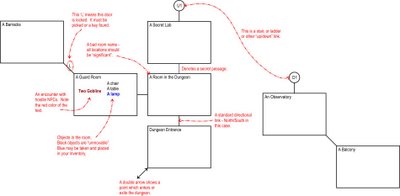 From the design file...
From the design file...Ok, here are some notes for the curious. So far the PBEM concept rocks. Problem is running it by hand for more than one or two players gets fancy. I keep emailing the wrong (or worse, incorrect) files out. I'm just too sloppy an organizer to do it right twice a day.
The biggest issue I'm having right now (systemic issue) is with the dungeons, however. Up to this point I've been using a card based dungeon idea to randomly generate the dungeons. If you've ever played Chainsaw Warrior, it's like that. You can skip down a bit.
If you haven't it works like this:
The player has a deck of cards. Each card represents a location in the dungeon. Each location presents a challenge to be faced, like an encounter with bad guys or a trap. If you resolve the card, you get to flip the next card over. Mixed into the deck is a "boss location". This card is the goal. When/if you flip that one over you fight an extra special encounter. This simulates exploring the dungeon.
Problem one is the cards come together in a disjointed, random manner, so the dungeons never have character. Problem two is, because the base set of cards was designed to be used as part of a game that was intended to last about 2 hours, they are not very diverse. You end up with a chain of "corridor", "stair", "store room", "corridor", "corridor"... it's like a Hanna-Barbara dungeon.
So I resolved to fix this. My first idea: full blown AD&D style dungeons (yes, I know it's not called Advanced Dungeons & Dragons anymore - I'm old, don't bug me). This gives me maximum fidelity when it comes to style. Now every dungeon can be a master piece, complete with thematic encounters, clever traps and evil. Problem is, I remembered after trying to do just one dungeon this way, every dungeon has to be a master piece. You can't just make it up off the cuff or the map starts to get out of whack, and in a way it's worse, because you've elevated the expectation of suspension of belief, and are now failing to deliver.
That brings us to cut three. See picture above, which is a graphical note on what I hope is going to be a better dungeon generator. I'm going to experiment with an Interactive Fiction style of map. Some of you (older than 25) may remember IF from the way back days when the Commodore name was home computing. There was a whole genre of games based on a text presentation of locations and parsing English (or at least English like) commands typed in at a prompt. They work like this.
Each "room" is a node on a network diagram. The nodes are attached by links in directions of the compass, and in many cases up down. Some times Up/Down links are direct - "You see a set of stairs going UP." Some times, they are indirect - "You see a ladder. It extends into a hole in the ceiling of the room.", in which case you would say "climb ladder" or "use ladder" and get up. But I digress.
I think the node based dungeon mixes the key points from both. It's still random. This is important as I want the players to be able to return to a dungeon area and explore it repeatedly, I don't want them to have to put up with the same 19 rooms each time. Well, at least not in exactly the same order.
I can create the dungeons with thematic groups.

For example I could plug in a secret lab, tower, observatory chain. I believe this mixing of "tile sets" is similar to how Blizzard works the map making logic for Diablo and Diablo II. So, now I just need to make a tool with all the rules and all the room sets that can, with the click of a button, whip up a new dungeon. Problem solved!
No comments:
Post a Comment